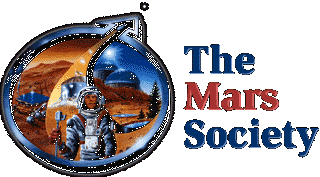| Chapter Links
Home Page
Calendar of Events
Ohio Chapter Mars Society Newsletters
Chapter Roster
Political Action -
Contacting
your Elected
Representatives
Ohio Links
Printable Mars Society - Ohio
Chapter Poster
Mars Society Links
Home Page
About Us and Donations
Mars Images and Charts
Mars Search Engine
International Sites
Canada
Germany
United Kingdom
Other
New Mars E-Zine
What's New
In the News
Bulletins
Steering Committee
Convention Details
Schedule
Co-Sponsors
Photo Gallery
|
. |
Copyright (c) 1998, Dayton Newspapers Inc.
DATE: Sunday, November 8, 1998 TAG: 9811080117
EDITION: CITY SECTION: SPECIAL PAGE: 23A
SOURCE: By Timothy R. Gaffney DAYTON DAILY NEWS
NASA HOPING FOR HIGH INTEREST
JOHNSON SPACE CENTER, Texas - Has John Glenn's
headline-grabbing returnto space fired up public
enthusiasm over the space program?
NASA sure hopes so. Its biggest project since the
moon landing, the
International Space Station, is finally about to
get off the ground. A
Russian rocket is scheduled to launch the first
element of the station on Nov. 20. Space shuttle
Endeavour is already on the launch pad with the
second
element, scheduled for launch Dec. 3.
When completed, it will be an orbiting behemoth
the size of a football
field with living space for seven astronauts.
NASA hopes to finish it in the
year 2004.
`If anything, I think STS-95 (Glenn's flight) has
regenerated interest in
space flight and space exploration,' Endeavor
commander Bob Cabana said.
Glenn made history in 1962 when he became the
first American to orbit the
earth. His second flight after 36 years caused
one of the biggest media
turnouts in the history of space flight, in sharp
contrast to the lack of
media interest in most shuttle flights.
Unlike the space race, which created one daring
adventure after another
until men landed on the moon, the 67 successful
space shuttle missions since
the Challenger accident in 1986 have had a
monotonous sameness that dulled
public interest.
Meanwhile, the space station has generated
interest mainly by its cost
and its countless delays. The original plan
announced by President Reagan in
1984 was to cost $8 billion and be finished by
1992.
Fourteen years later, the first pieces are just
now on the launch pads
and the price tag is estimated at anywhere from
$21 billion to $96 billion based on costs over
the station's lifetime, according to a
congressional estimate.
And NASA's schedule is still in doubt because a
key piece, a Russia-supplied
service module needed to keep the station in
orbit, has been delayed for
lack of funding because of Russia's economic
crisis.
Even Glenn expressed disappointment in the
station's progress during a
news conference from space. `I had hoped the
space station would come along a little bit
faster than it has,' he said.
NASA has touted the space station as the most
complex construction
program in history and the biggest international
space project ever, with 443 tons of hardware
being built by 16 nations.
But it isn't the first space station ever. Russia
has had a series of
space stations over the years, culminating in the
still-occupied Mir. America
cobbled Skylab together in 1973 from Apollo
hardware left over after
President Nixon canceled the last scheduled moon
flights. It fell out of orbit in 1979.
Science journalist Andrew Chaikin, author of A
Man on the Moon , worries
that Americans' attention spans are too short to
stay interested in a long-term project like the
International Space Station. `I think we have an
enormous problem in this country with the fact
that it's harder to get people's attention for
more than 10 minutes,' he said.
But the orbital construction work will provide
plenty of high-wire drama,
predicts John Pike, a space analyst with the
Washington, D.C. based
Federation of American Scientists. `It's
certainly going to be a lot more interesting than
the shuttle program, where they went up,
tormented insects and came back down,' he said.
In fact, Endeavor's mission next month will
require three spacewalks to get the first two
elements hooked up and running.
Like the moon program, space station construction
will keep the public
interested because it has a storyline, Pike
predicted. `(It) is going to take you back to the
'60s where there is a beginning, a middle and an
end,' he said. But, then what?
`The purpose of the space program really has been
to extend our reach to
new worlds,' said rocket scientist Robert Zubrin,
founder and president of
the Colorado-based Mars Society. `The challenge
that's been staring NASA in the face since 1973
(the year following the last moon flight) has
been Mars.'
Zubrin is the chief advocate for a grassroots
movement to get the U.S. to
commit to a manned Mars program. He organized the
Mars Society at an August founding conference
that drew 700 people. He said the organization
now has 50 chapters across the U.S. and 20 in
foreign countries.
Zubrin believes the technology exists to put
humans on Mars in 10 years.
What's lacking, he said, is the political will to
do it. President Bush set a 30-year goal of
sending an expedition to Mars but never pushed
the idea. President Clinton has set no such goal.
Zubrin thinks Glenn's flight might help focus
public attention on the issue. `It's had massive
value as a stimulus for reflection' on America's
space accomplishments in the 1960s, he said. `We
had a space program to storm heaven. We developed
hydrogen-fueled engines and nuclear space power,
interplanetary navigation and data relays ... the
entire bag of tricks NASA uses today.'
Glenn's flight, he said, `is putting to us the
question of whether we should continue.'
|
|



